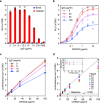A homogeneous split-luciferase assay for rapid and sensitive detection of anti-SARS CoV-2 antibodies
- PMID: 33753733
- PMCID: PMC7985487
- DOI: 10.1038/s41467-021-22102-6
A homogeneous split-luciferase assay for rapid and sensitive detection of anti-SARS CoV-2 antibodies
Abstract
Better diagnostic tools are needed to combat the ongoing COVID-19 pandemic. Here, to meet this urgent demand, we report a homogeneous immunoassay to detect IgG antibodies against SARS-CoV-2. This serological assay, called SATiN, is based on a tri-part Nanoluciferase (tNLuc) approach, in which the spike protein of SARS-CoV-2 and protein G, fused respectively to two different tNLuc tags, are used as antibody probes. Target engagement of the probes allows reconstitution of a functional luciferase in the presence of the third tNLuc component. The assay is performed directly in the liquid phase of patient sera and enables rapid, quantitative and low-cost detection. We show that SATiN has a similar sensitivity to ELISA, and its readouts are consistent with various neutralizing antibody assays. This proof-of-principle study suggests potential applications in diagnostics, as well as disease and vaccination management.
Conflict of interest statement
A patent covering all of the main aspects/key elements of SATiN has been filed by the governing council of the University of Toronto (application number: US PROVISIONAL 63/121,689). The application is currently pending. I.S. and Z.Y. are named as co-inventors on the patent application. The remaining authors declare no competing interests.
Figures




Similar articles
-
Suitability of two rapid lateral flow immunochromatographic assays for predicting SARS-CoV-2 neutralizing activity of sera.J Med Virol. 2021 Apr;93(4):2301-2306. doi: 10.1002/jmv.26697. Epub 2020 Dec 17. J Med Virol. 2021. PMID: 33236799 Free PMC article.
-
Inference of SARS-CoV-2 spike-binding neutralizing antibody titers in sera from hospitalized COVID-19 patients by using commercial enzyme and chemiluminescent immunoassays.Eur J Clin Microbiol Infect Dis. 2021 Mar;40(3):485-494. doi: 10.1007/s10096-020-04128-8. Epub 2021 Jan 6. Eur J Clin Microbiol Infect Dis. 2021. PMID: 33404891 Free PMC article.
-
Development, performance evaluation, and clinical application of a Rapid SARS-CoV-2 IgM and IgG Test Kit based on automated fluorescence immunoassay.J Med Virol. 2021 May;93(5):2838-2847. doi: 10.1002/jmv.26696. Epub 2021 Mar 1. J Med Virol. 2021. PMID: 33231312 Free PMC article.
-
Evaluation of Three Quantitative Anti-SARS-CoV-2 Antibody Immunoassays.Microbiol Spectr. 2021 Dec 22;9(3):e0137621. doi: 10.1128/spectrum.01376-21. Epub 2021 Dec 22. Microbiol Spectr. 2021. PMID: 34937195 Free PMC article.
-
Evaluation of a multiplexed coronavirus antigen array for detection of SARS-CoV-2 specific IgG in COVID-19 convalescent plasma.J Immunol Methods. 2021 Oct;497:113104. doi: 10.1016/j.jim.2021.113104. Epub 2021 Jul 22. J Immunol Methods. 2021. PMID: 34303688 Free PMC article.
Cited by
-
Experimental and Analytical Framework for "Mix-and-Read" Assays Based on Split Luciferase.ACS Omega. 2022 Jul 1;7(28):24551-24560. doi: 10.1021/acsomega.2c02319. eCollection 2022 Jul 19. ACS Omega. 2022. PMID: 35874239 Free PMC article.
-
Rapid Quantification of C. difficile Glutamate Dehydrogenase and Toxin B (TcdB) with a NanoBiT Split-Luciferase Assay.Anal Chem. 2022 Jun 14;94(23):8156-8163. doi: 10.1021/acs.analchem.1c05206. Epub 2022 May 28. Anal Chem. 2022. PMID: 35634999 Free PMC article.
-
Cell-Free Dot Blot: an Ultra-Low-Cost and Practical Immunoassay Platform for Detection of Anti-SARS-CoV-2 Antibodies in Human and Animal Sera.Microbiol Spectr. 2023 Jan 31;11(2):e0245722. doi: 10.1128/spectrum.02457-22. Online ahead of print. Microbiol Spectr. 2023. PMID: 36719206 Free PMC article.
-
Simple, Rapid Chemical Labeling and Screening of Antibodies with Luminescent Peptides.ACS Chem Biol. 2022 Aug 19;17(8):2179-2187. doi: 10.1021/acschembio.2c00306. Epub 2022 Jul 21. ACS Chem Biol. 2022. PMID: 35862857 Free PMC article.
-
Luciferase-Based Biosensors in the Era of the COVID-19 Pandemic.ACS Nanosci Au. 2021 Aug 9;1(1):15-37. doi: 10.1021/acsnanoscienceau.1c00009. eCollection 2021 Dec 15. ACS Nanosci Au. 2021. PMID: 37579261 Free PMC article. Review.
References
-
- Weissleder, R., Lee, H., Ko, J. & Pittet, M. J. COVID-19 diagnostics in context. Sci. Transl. Med. 12, eabc1931 (2020). - PubMed
Publication types
MeSH terms
Substances
LinkOut - more resources
Full Text Sources
Other Literature Sources
Medical
Miscellaneous

